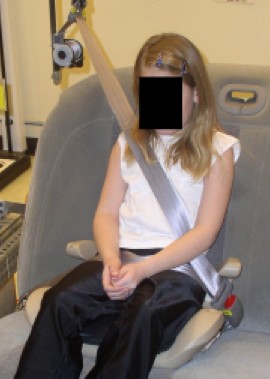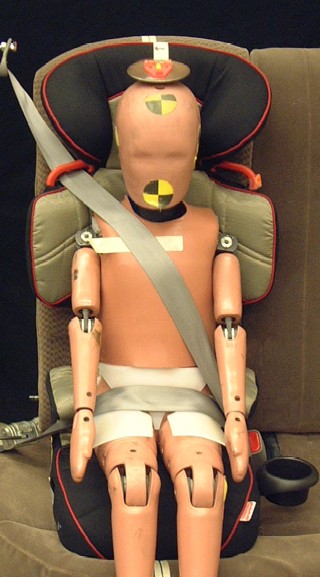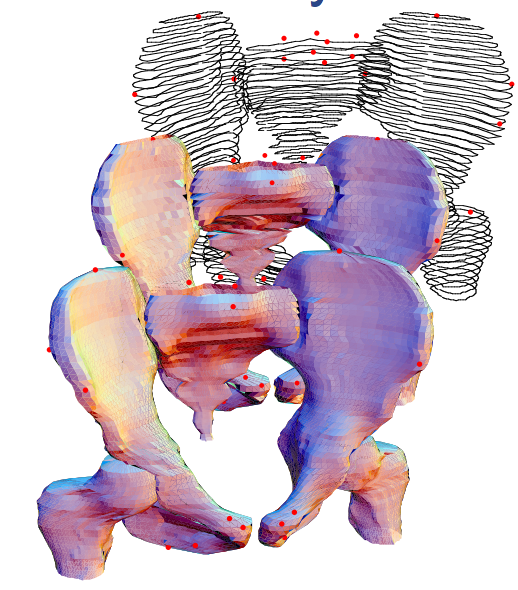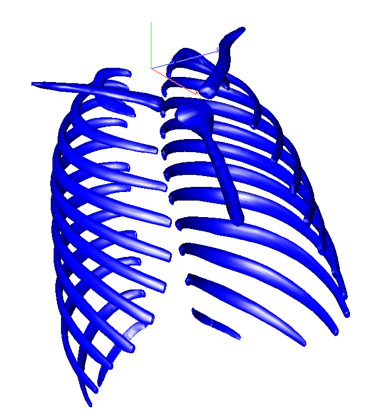>>> Research: Child Passenger Safety
Protecting Children in Crashes
The Biosciences Division at UMTRI has been active in child passenger safety research for many years. Our current focus is on improvements to child restraints and the crash dummies that are used to assess them. This page lists some highlights of recent projects.
Child Posture and Belt Fit

Children from 4 to 8 years of age who use vehicle belts as their primary restraint are at increased risk for abdominal injury if they do not use belt-positioning boosters. The increased risk is believed to result from poor belt fit that places the belt over the soft abdomen rather than the bony pelvis. We have conducted a series of studies to address issues relating to crash protection for this age group. We used methods originally developed to measure posture and belt fit for adults to quantify the effects of seat geometry on belt fit. We developed the laboratory conditions based on detailed measurements of second-row seat and belt geometry in 30 passenger cars, SUVs, and minivans. The results demonstrate that some second row belt configurations produce significantly poorer belt fit across a range of occupant sizes. We have used the data from these laboratory measurements of children to improve crash dummy design and to develop new methods for positioning crash dummies.
Two technical reports are available on this work:
Assessing Child Belt Fit, Volume I: Effects of Vehicle Seat and Belt Geometry on Belt Fit for Children with and without Belt Positioning Booster Seats
Assessing Child Belt Fit, Volume II: Effects of Restraint Configuration, Booster Seat Designs, Seating Procedure, and Belt Fit on the Dynamic Response of the Hybrid-III 10-year-old ATD in Sled Tests
Belt Fit in Belt-Positioning Boosters

Children who are not using harness restraints and who are too small to achieve good belt fit with the vehicle belt alone should use a belt-positioning booster. The booster raises the child, typically about 4 inches, improves lap and torso belt fit, restricts the posture to provide better belt interaction, provides better lower-extremity comfort, and gives the child a better view out of the vehicle. Field data indicate that belt positioning boosters greatly reduce the risk of abdominal injury over belts alone and also provide a significant reduction in fatality risk. However, our research on belt fit has shown that boosters vary widely in the belt fit that they provide. We have developed a laboratory test procedure to measure belt fit using Hybrid-III crash dummies and have used this procedure to measure the belt fit in dozens of boosters. The results can be used to predict the belt fit that children of various sizes will experience in the booster.
Pelvis Geometry from CT Scans

The performance of belt-positioning booster seats used by children who are too small to achieve good belt fit with vehicle belts alone, and no longer riding in harness restraints, is assessed in U.S. regulatory tests using Hybrid-III dummies. Unfortunately, these dummies interact with belt restraints in unrealistic ways. The lap, shoulder, and chest areas where the belt contacts the dummy are of particular concern, because the dummy geometry in these areas is substantial different from the skeletal anatomy of similar-size children. We are working on developing improved components for the dummies, starting with the Hybrid-III six-year-old. We have developed new methods for extracting and analyzing the shapes of anatomical structures from medical imaging data. We've used these methods to create a statistical model of the child pelvis based on data from over 80 children from ages 4 to 12. The analysis allows us to create the typical three-dimensional pelvis size and shape for any child in that age range. We've used this model to create a geometric target for the 6YO Hybrid-III pelvis. The figure compares the shape of the target pelvis to the current Hybrid-III pelvis.
Thorax Geometry for Child Crash Dummies

As with the pelvis and lap area, the shoulder and chest of the Hybrid-III dummy family have unrealistic geometry. Our analysis of CT data has continued with the creation of a parametric model of the child ribcage and clavicle based on data from over 80 children ages 5 to 11. Comparison of the model to the geometry of the Hybrid-III 6YO shows a good match on overall size, but the Hybrid-III ATD ribs lack the appropriate angle and contour. The shoulder area is of particular concern, because the belt interaction with the clavicle and upper ribcage may be important to producing accurate kinematics in crash simulations.
Positioning Child Crash Dummies

Belt-positioning boosters are evaluated in U.S. Federal certification tests using Hybrid-III dummies. The 6YO is installed using procedures similar to those originally developed for positioning dummies in harness restraints. Our research has shown that the positions produced by those procedures are significantly different from the postures of similar-size children, which are characterized by more-forward pelvis locations. Using data from laboratory measurements on child volunteers, we have developed new positioning procedures for the 6YO and 10YO Hybrid-III dummies that place the heads and hips of the dummy in more realistic positions. Our methods also use realistic belt tension for three-point belts donned by children rather than the high tensions specified in FMVSS 213.
©2024 Matthew P. Reed and The University of Michigan